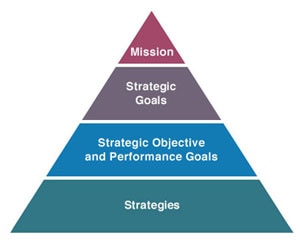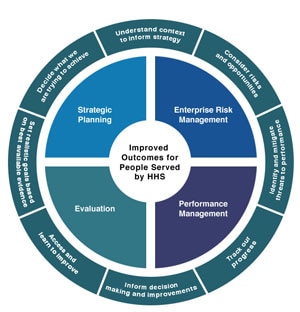Overview: HHS Strategic Plan, FY 2018-2022
- Overview: HHS Strategic Plan, FY 2018-2022
- Strategic Plan Development
- Strategic Goals, Objectives, and Strategies
- Performance Tracking
- Major Management Priorities and Challenges
- Evaluation and Evidence for the HHS Strategic Plan
- Contributing Programs for Strategic Objectives
Overview: HHS Strategic Plan, FY 2018-2022
Strategic Plan Development
Every four years, HHS updates its strategic plan, which describes its work to address complex, multifaceted, and evolving health and human services issues. An agency strategic plan is one of three main elements required by the Government Performance and Results Act (GPRA) of 1993 (Pub. L. 103–62) and the GPRA Modernization Act of 2010 (Pub. L. 111–352). An agency’s strategic plan defines its mission, its goals, and the means by which it will measure its progress in addressing specific national problems over a four-year period. OMB Circular A-11, Preparation, Submission, and Execution of the Budget, Part 6, Strategic Plans, Annual Performance Plans, Performance Reviews, and Annual Program Performance Reports, and OMB Memorandum M-17-22, Comprehensive Plan for Reforming the Federal Government and Reducing the Federal Civilian Workforce, provided guidance on how to prepare this Strategic Plan.
All operating divisions and staff divisions within HHS contributed to the development of the HHS Strategic Plan FY 2018–2022 (Strategic Plan), as reflected in its Strategic Goals, Strategic Objectives, and strategies. The Strategic Plan’s content aligns with the priorities of the Administration and HHS.
Under the GPRA Modernization Act, Federal agencies are required to consult with Congress and to solicit and consider the views of external parties. To comply with this mandate, HHS engaged the public through the HHS website, a Notice of Availability in the Federal Register, conference calls and consultation sessions with Tribal leaders, email notices to external stakeholders and HHS.gov subscribers, and social media postings. The public could review the draft Strategic Plan on the HHS website or could request an electronic or paper copy. The public was able to submit comments via mail, fax, email, and the HHS website. HHS also sought input from Congress and the Office of Management and Budget.
More than 13,000 comments from the public were received during the 31-day public comment period, which ended on October 27, 2017. Members of Congress also sent feedback on the draft. Input ranged from editorial suggestions to more substantive comments. In response, HHS coordinated with subject matter experts, policy and program analysts, and research and evaluation staff within the operating divisions and staff divisions to incorporate responsive changes into the final Strategic Plan.
Any updates to the Strategic Plan will be made on an annual basis, and updates will be outlined in an appendix.
 Strategic Goals, Objectives, and Strategies
Strategic Goals, Objectives, and Strategies
This Strategic Plan describes HHS’s efforts within the context of five broad Strategic Goals:
- Strategic Goal 1: Reform, Strengthen, and Modernize the Nation’s Healthcare System
- Strategic Goal 2: Protect the Health of Americans Where They Live, Learn, Work, and Play
- Strategic Goal 3: Strengthen the Economic and Social Well-Being of Americans Across the Lifespan
- Strategic Goal 4: Foster Sound, Sustained Advances in the Sciences
- Strategic Goal 5: Promote Effective and Efficient Management and Stewardship
The Strategic Goals and associated Objectives focus on the major functions of HHS and outcomes the Department aims to achieve. Primary strategies for accomplishing HHS’s goals are presented with each Objective. Although the Strategic Goals and Objectives are presented in the Strategic Plan in separate sections, they are interrelated, and successful achievement of one  Strategic Goal or Objective can influence the success of others. Multiple divisions within HHS often contribute to successful achievement of a Strategic Goal or Objective; divisions that make these contributions to Strategic Goals and Objectives are listed within the appropriate sections of the Strategic Plan.
Strategic Goal or Objective can influence the success of others. Multiple divisions within HHS often contribute to successful achievement of a Strategic Goal or Objective; divisions that make these contributions to Strategic Goals and Objectives are listed within the appropriate sections of the Strategic Plan.
HHS is working to integrate strategic planning, performance measurement and management, enterprise risk management, and evaluation into its management approach. Although the sections that follow—Performance Tracking, Major Management Priorities and Challenges, and Evaluation and Evidence—were developed by different divisions within the Department, these efforts are aligned in the context of the Strategic Plan.
Performance Tracking
Performance Goals. The GPRA Modernization Act and related guidance from the Office of Management and Budget requires the inclusion of performance goals for each Strategic Objective in the Strategic Plan. In developing and selecting performance goals, HHS included measures of the broad impact of health and human services as well as intermediate processes and outputs that contribute to the achievement of long-term outcomes. HHS personnel regularly monitor more than a thousand performance measures to examine effectiveness and improve program processes. This Strategic Plan includes a subset of important performance goals that track progress for those objectives. Progress on these performance goals will be tracked annually through the Annual Performance Report.
Agency Priority Goals. Among the performance measures monitored by the Department are several measures that support the Department’s Priority Goals. These goals are a set of ambitious but realistic performance objectives that the Department will work to achieve within a 24-month period. Agency Priority Goals support and align with the Strategic Goals and Objectives of the HHS Strategic Plan. The GPRA Modernization Act requires the inclusion of these Priority Goals in the Department’s Strategic Plan and Annual Performance Plan. Agency Priority Goals for FY 2018–2019 will be reported in Annual Performance Plans and Reports beginning in 2019. Current information on Agency Priority Goals can be found at https://www.Performance.gov.
Cross-Agency Priority Goals. The GPRA Modernization Act requires that the Department address Cross-Agency Priority (CAP) Goals in its quadrennial Strategic Plan, the Annual Performance Plan, and the Annual Performance Report. The Department’s contributions to and progress on CAP Goals will be available at https://www.Performance.gov.
Major Management Priorities and Challenges
According to OMB Circular A-11, an agency’s strategic plan must include a section on major management challenges, to describe management and programmatic issues and risks or areas that have greater vulnerability to waste, fraud, abuse, and mismanagement or where a failure to perform could seriously affect the agency’s mission delivery and ability to achieve its goals. The Office of Inspector General (OIG) annually identifies top management and performance challenges facing the Department as it strives to fulfill its mission. OIG notes that challenges can arise in the Department’s responsibilities and functions, such as delivering quality services and benefits, exercising sound fiscal management, safeguarding public health and safety, and enhancing cybersecurity. Efforts to strengthen these functions are described in Strategic Goal 5: Promote Effective and Efficient Management and Stewardship. OIG also identified challenges that exist in programs, including Medicare, Medicaid, the Public Health Service, and the Indian Health Service. The Government Accountability Office (GAO) has listed four HHS programs, including Medicare, Medicaid, food safety, and medical product oversight, on its High Risk List, which lists programs with greater vulnerabilities to fraud, waste, abuse, and mismanagement. Several other items on the GAO High Risk List also implicate HHS: Improving Federal Management of Programs that Serve Tribes and Their Members; Improving and Modernizing Federal Disability Programs; and Ensuring the Security of Federal Information Systems and Cyber Critical Infrastructure and Protecting the Privacy of Personally Identifiable Information. Efforts to strengthen these programs are described across Strategic Goal 1: Reform, Strengthen, and Modernize the Nation’s Healthcare System and Strategic Goal 2: Protect the Health of Americans Where They Live, Learn, Work, and Play. In addition to responding to risks identified by OIG and GAO, the Department is implementing an enterprise risk management (ERM) approach to its work. References to ERM are included throughout the document, especially in Strategic Goal 5: Promote Effective and Efficient Management and Stewardship.
Evaluation and Evidence for the HHS Strategic Plan
Evaluation and analysis provide essential evidence for HHS to understand how, for whom, and under what circumstances its programs work. HHS builds evidence through evaluation and analysis to inform decisions in budget, legislative, regulatory, strategic planning, program, and policy arenas. Given the breadth of work supported by HHS, many evaluations and analyses are conducted each year. These efforts range in scope, scale, design, and methodology, but all aim to understand the effect of programs and policies and how they can be improved.
Evaluation at HHS: Across HHS, evaluation comes in many forms, including (1) formal program evaluations using the most rigorous designs that are appropriate; (2) capacity-building initiatives to improve administrative data collection, accessibility, and use for management; (3) exploratory and preliminary quantitative and qualitative analysis to build evidence; (4) pilots and demonstrations; and (5) statistical analysis of factors related to health and human services programs and policies. Findings from a variety of evaluations and analyses are disseminated to the public on HHS agency websites, such as those of the Administration for Children and Families Office of Planning, Research, and Evaluation and the Innovation Center at the Centers for Medicare & Medicaid Services. HHS coordinates the evaluation community by regularly convening the HHS Evaluation & Evidence Policy Council, which builds capacity by sharing best practices and promising new approaches across HHS.
Data Collection, Analysis, and Policy: Across HHS, decisions about programs, regulations, and policies are informed by a broad range of evidence generated through analysis of data collected from multiple sources. The robust HHS data portfolio serves as the foundation for evidence building. The data collection systems supported by HHS provide most of the national statistical capacity to monitor the health of the population and the functioning of the healthcare and human services systems. They support the tracking of national health objectives and the identification of trends, and they inform program and policy decision making associated with the missions of all HHS agencies. Evidence is developed by analyzing data to answer policy research questions. Data policy shapes the information available for evidence-building to support decision making. HHS also convenes the HHS Data Council, the principal internal advisory body to the Secretary of HHS on data and statistical policy, which facilitates collaboration and coordination among various divisions involved in evidence building. An important activity of the HHS Data Council includes leveraging HHS statistical and administrative data collection to support evidence building.
Disseminating Evidence: In addition to building evidence through a broad range of rigorous empirical studies, analyses, and evaluations, HHS supports multiple clearinghouses that catalog, review, and disseminate evidence related to programs, such as the Administration for Children and Families Research and Evaluation Clearinghouses on Self-Sufficiency, Employment Strategies, Strengthening Families, Home Visiting, and Child Care and Early Education; the Agency for Healthcare Quality and Research United States Preventive Services Task Force; and the Centers for Disease Control and Prevention Community Guide.
Throughout this Strategic Plan, narrative sections under the Strategic Goals and Objectives describe how evaluations contributed to the strategic directions that the Department has chosen in its efforts to improve health and human services for the populations it serves. This Strategic Plan also includes strategies related to conducting research and evaluations and applying that knowledge to improve programs and other efforts.
Contributing Programs for Strategic Objectives
The GPRA Modernization Act requires that the Department prepare a central inventory of all Federal programs. This program inventory is intended to facilitate coordination across programs, make it easier to find programs that contribute to a shared goal, and improve public understanding about what Federal programs do and how the programs link to budget, performance, and other information.
The HHS Program Inventory describes the programs that HHS administers across its 11 operating divisions, as well as how programs support the Department’s broader Strategic Goals and Objectives. In developing the HHS Program Inventory, HHS worked to closely align the list to the Department’s budget structure and Treasury accounts. This approach is consistent with how the Department operates and serves the American people and generally reflects the way Congress appropriates funding to HHS.